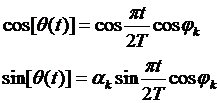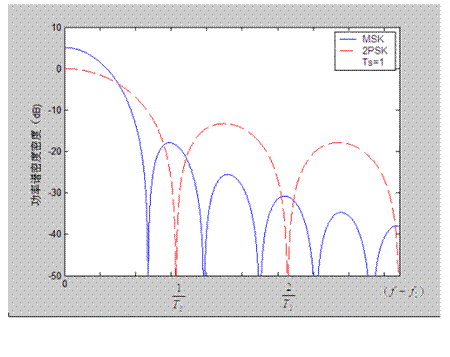|
Mathematical introduction to GFSK
MSK
Here let¨s consider the basic modulation and
demodulation techniques used in Transmitter & Receiver.
Generally, Bluetooth implements a very basic and popular
digital modulation, say GMSK.
Let¨s begin from the very beginning
and go through every detail about the configuration of
MSK. MSK is the abbreviated for Minimum Frequency
Shift-Keying. As a special form of FSK, MSK also denotes
binary signals with two different frequencies,  and and  : :

But there is another constrain
anyhow. In order to enable and simplify the
demodulation, it is desired that the two different
signals when sending '0' and '1' are orthogonal to each
other, mathematically:

Here T
denotes the time to transmit one bit information.
To make the first part zero,  should
be equal to should
be equal to .
Subsequently, when k=1, .
Subsequently, when k=1,  will
have the minimum value, from which the name MSK comes. will
have the minimum value, from which the name MSK comes.
On this
occasion,


In
another equation, we can definite a new parameter:

To make
the second part null,

By now,
it is easy to see:



With the knowledge above, we can get:

Here is
the information of the kth bit, '+1' or '-1', . For
example, when data '1' is send, is
the information of the kth bit, '+1' or '-1', . For
example, when data '1' is send,  : :

Further more, in order to keep the phase in the
connection continuous, should
satisfy: should
satisfy:

When setting ,
there will be a very interesting conclusion that ,
there will be a very interesting conclusion that is
either is
either or or , and , and
 is
by no means equal to 0 is
by no means equal to 0

Though another conclusion is ambiguous, but it is true.
If readers are interested in it, playing the trick will
be very useful.

From the expand of equation for MSK,
we can easily get an intuition on how to make up a
device to implement it.

And specially,


Where

 is
bipolar digital data. is
bipolar digital data.
And as the result of one conclusion mentioned above,

Which means that  can
never be changed in time T, but in time 2T. So this is
the reason to use a time delay device in the
implementation configuration.
can
never be changed in time T, but in time 2T. So this is
the reason to use a time delay device in the
implementation configuration.
To make the specification more clearly, a graph is
presented below:

With no prove and process, MSK signal¨s PDF can be
formulized as

It is clear that MSK's main lobe is denser than binary PSK, shrinking into a narrower
band. It is more suitable for transmission.

GMSK
Anyhow, on some application occasion
(especially the communication), MSK also
seems too wide in bandwidth for transmission and
economy's sake. Such occasions may requires the decay outside the main
lobe reaching up to 70-80dB. To solve such a severe
requirement, a pre-filter locating before ordinary MSK
Module will promise, which is called Gaussian Lowpass Filter. Gaussian LPF should meet the criteria
below:
1.
Narrow bandwidth and transition band should be as
narrow as possible;
2.
With short impulse
response;
3.
Keep the impulse
response area constant.
A usually used Gaussian Lowpass
Filter can be described with its transfer function as
blow:

With inverse Fourier Transform, its
impulse response can be achieved:

Usually, its 3dB bandwidth
 is
multiplied with the duration of sending
one bit
is
multiplied with the duration of sending
one bit  to measure
the characteristics of Gaussian LPF.
to measure
the characteristics of Gaussian LPF.
What should be pointed out is that,
though Gaussian LPF makes the system satisfactory with
the spectrum requirement, it achieves its goal with cost
of satisfying BER. The narrower
the transition band is, the better the spectrum becomes,
and consequently the worse the BER gets. As a thumb rule
of experiment, When ,
BER doesn¨t decline a lot, also the bandwidth is somewhat
acceptable. ,
BER doesn¨t decline a lot, also the bandwidth is somewhat
acceptable.
GFSK
MSK and GMSK all require that h=0.5, which limits the
modulation too much. An alternative technique is to use
GFSK. GFSK don't limit h to exact 0.5, any h between 0.4
to 0.7 will do.
|